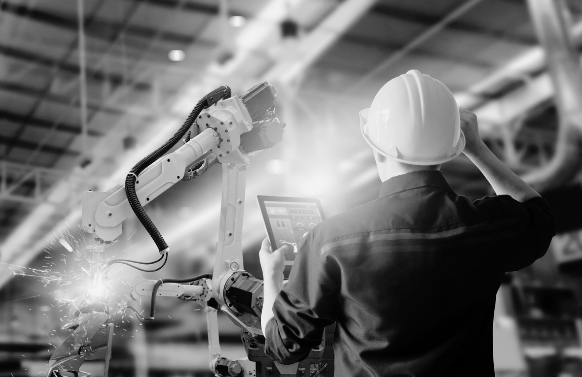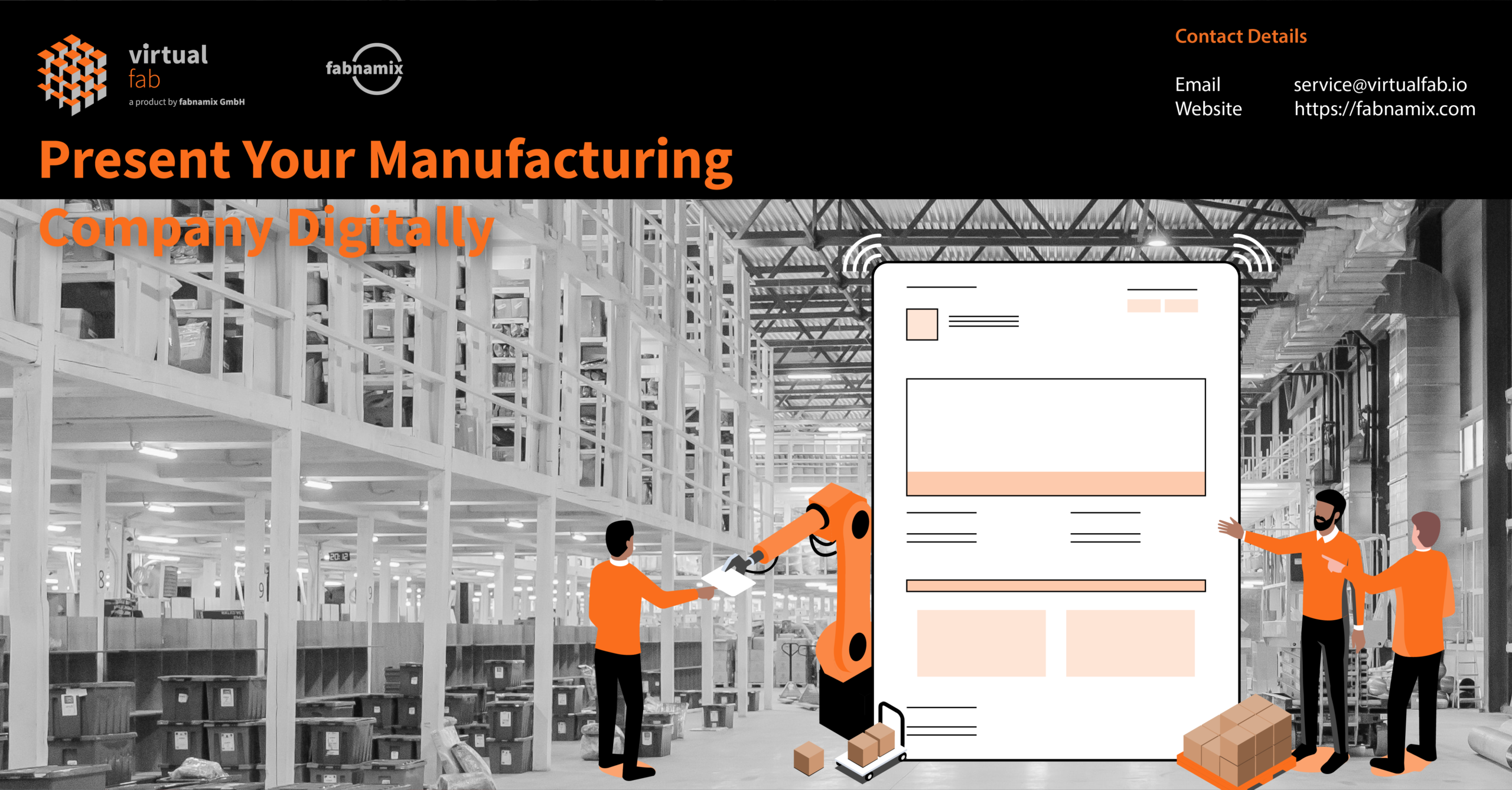
Manufacturing 4.0: the importance of a strong digital presence as a modern manufacturer
Digitization’s impact on the manufacturing industry
The digitization is impacting all areas of business, including the manufacturing industry. Now this is not new to anyone, but many companies still face struggles when it comes to implementing new digital technologies into their day-to-day business. Digitization has restructured various areas of corporate life, including ways of communication, the handling of information as well as the processes of producing goods.
But what are we talking about when we speak of digitization in manufacturing? The most common term of recent years has been the so-called Industry 4.0, which is having a major impact on all areas of industrial production. The fourth industrial revolution is driven by digitization and thus transforms all industrial value chains.
Industry 4.0
Industry 4.0 is an umbrella-term for describing the ground-breaking and rapid changes brought upon the manufacturing industry by the digitization. It was first brought up in 2011 and has since been related to the internet of things, cyber physical systems and new information and communication technologies.
There are four main driving factors here:
- The extraordinary rise in data volumes, computational power and connectivity
- The growing appearance of analytics and business-intelligence capabilities
- New ways of human-machine interaction such as touchscreens and augmented reality
- Advanced ways to transfer digital instructions into the physical world, for example by 3D-printing
The combined goal of Industry 4.0 is to transform industrial value chains to achieve a higher level of organizational control over all business processes. This in turn leads to the optimization of products, services and workflows. It is meant to increase production efficiency while also reducing costs at the same time.
Furthermore, the advancements in communication systems and databases, logistics processes and organizational collaborations have increased many companies’ overall efficiency. The improved ways of communication offer better ways to handle customer relation and thus provide a boost to supplier-customer-relationships.

With the changes of Industry 4.0 also came several developments in the consumer market. One example of that is the change in demands, shifting from standardized products to more and more individualized products with overall higher requirements. These requirements can be achieved in multiple ways, for example by utilizing digital tools to automate processes or improving the intercompatibility of processes. This frees up capacities to work on improving product quality and speeding up the time-to-market.
Now to summarize, Industry 4.0 relies on the institutionalization and integration of various modern information and digital technologies. It focuses on equipment connectivity and creates value by maximizing efficiency and automation.
But it does not stop there. After the focus was set on technological equipment for the past years, there is a new shift that is impacting the manufacturing industry once again.
The shift to Industry 5.0
Industry 5.0 is the new shift we are seeing in the manufacturing industry, and it essentially brings to focus back to the humans rather than technological tools or robotics. This means that the management of the human interaction with these new technologies from the Industry 4.0 is growing in importance. It is the result of the realisation that even with highly advanced technologies, the human cognitive power and analytical capabilities remain irreplaceable.
This implies a rising interest in improving people’s experiences within the processes of creating a product as well as consuming it. The value creating now stems from improving the quality of life, especially considering customer experience.
But what implications does this new development have for you and your company?
The growing importance of customer experience in manufacturing
The rising importance of customers experience (CX) is a result of the new level of availability of information, both about companies and about customers, as well as the increased customization even in areas of marketing and customer relations.

Online tools in specific create a number of new touchpoints through which customers can now interact with your company. Market reports of recent years reflect the increased importance of CX from the perspective of customers of industrial goods.
These studies state that 80% of customers think that the experience a company provides for their clients is just as important as their products or services. Another 65% are willing to pay more for a great experience and 57% have stopped buying from a specific company because their competitor provided a better experience (Rekettye, Rekettye Jr. 2020).
Especially the last point shows another trend in customer behaviour, referring to a higher comfortability with switching brands. The reasons for this are lower switching barriers and the easy availability of information about competitors.
But what exactly is customer experience?
The term customers experience covers everything your customer goes through from the point of first contact until after sales-service. It is defined by various touchpoints between your company and your clients. The exact customer experience is created as a result of the satisfaction of the buyer with the touchpoints of the supplier.
Typically, the customer will follow a specific decision journey to figure out which company fits their requirements best. This journey starts with the initial consideration of a set of brands based on the customers previous experience, their perceptions and recent exposure.
The customer will actively evaluate each brand and add more or subtract the ones they don’t find fitting to their needs. Ultimately, one brand will be selected, and the customer will make their purchase. The journey does not end here since the post-purchase experience plays another important role in the overall customer experience. Finally, all of the client’s experiences during this process will build expectations that influence their next decision and could possibly lead to them becoming a loyal customer.
If we follow this process, it becomes clear that the evaluation part of the journey is possibly the most important one to set yourself apart from competitors. To be able to do that effectively, you need to know where your customers will be looking for that extra information about your brand.
There is a simple answer to that: most likely your customer will go online to find out more about your company. It comes to no surprise that almost all research is done online nowadays because it is simple and offers fast results. The almost endless availability of information is another bonus that makes online research the natural choice when evaluating a brand.
As already mentioned, customer’s requirements are growing steadily, which results in a hyper competitive environment for most companies. Additionally, buyers now expect to be able to search your website for information about your products and services just as easily as if they were privately browsing for items on any e-commerce platform.

So how can you improve your online presence to stand out from your competitors and put your company in a favourable position?
How you can improve your customer experience online
First of all, the main point of interaction with your customers will most likely be your website. So it is important to put in enough time and effort to create an effective website and continuously measure its performance.
When you have established your online presence, there are a few things that can help improving your customer’s experience:
- Easily available information: make sure that your customers or anyone who is interested in your company can effortlessly find out more about your company’s assets and skills. Clearly display all products and services your company provides and make sure to keep this information updated.
- Create simple ways of communication: It is always great to actively reach out to potential customers and start a conversation with them. However, you might not always have time for that and in global markets, your potential customer might be in a completely different time zone. So it is recommended to create an easy way for your customers to get in contact with you. May that be through a webform, an integrated chat tool or just by providing an e-mail address and business phone number.
- Set yourself apart from the majority: There are multiple ways to achieve this goal, however a great starting point is to offer your customers more information about your company. Let them know if you offer very specific manufacturing technologies or have special certificates that qualify you as an extraordinary supplier.
- Provide visual content: Photos and graphics are very appealing to anyone who visits your site and will keep their level of interest higher than if you were just providing them with plain text. Sharing high-quality and detailed information about your company and supporting it with meaningful visual content will set you up for a successful online presence.

How virtualfab supports your online presence as a manufacturing company
Our software virtualfab provides a feature that enables you to easily create a visually appealing portfolio of your company. This includes:
- General information about your company, for example the name, founding date and number of employees
- The services your company provides, such as the manufacturing technologies that you can operate
- An overview of your company’s certificates and other specifications
- A detailed description of your company
All of this content can be accompanied by your pictures. Just by inputting this information into virtualfab and adding the photos you would like; a portfolio page will be created automatically. This page includes all the data you provided and arranges it in a visually appealing way. Not only that, but you can also easily share the portfolio and embed it onto your website.
Does this sound interesting for you and your company?
Let’s have a talk about how virtualfab can support your company’s online presence!

Sources:
Nahavandi, S. (2019) Industry 5.0 – A Human-Centric Solution. Institute for Intelligent Systems Research and Innovation, Deakin University, Waurn Ponds 3216, Australia Sustainability 2019, 11(16), 4371; DOI: 10.3390/su11164371
Rekettye, G.; Rekettye Jr, G. (2020) The Changing Role of Customer Experience in the Age of Industry 4.0. University of Pecs, Hungary; International Business School Budapest, Hungary. DOI: 10.15170/MM.2020.54.01.02
Skobelev, P.; Borovik, Y. (2017) On the way from Industry 4.0 to Industry 5.0: From digital manufacturing to digital society. International Scientific Journal “Industry 4.0”. YEAR II, ISSUE 6, P.P. 307-311
Ghobakhloo, M.; Iranmanesh, M. (2021) Digital transformation success under Industry 4.0: a strategic guideline for manufacturing SMEs. Journal of Manufacturing Technology Management. DOI: 10.1108/JMTM-11-2020-0455
